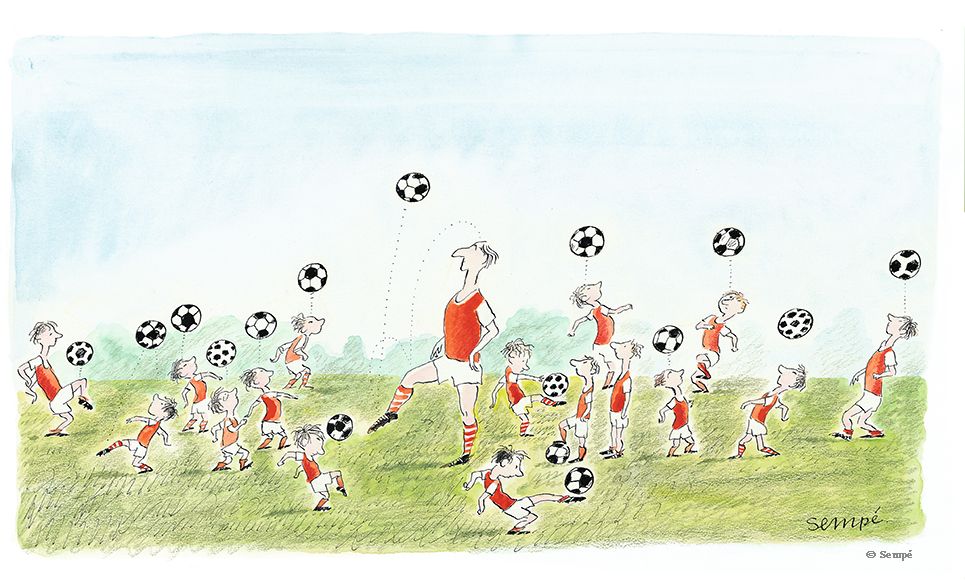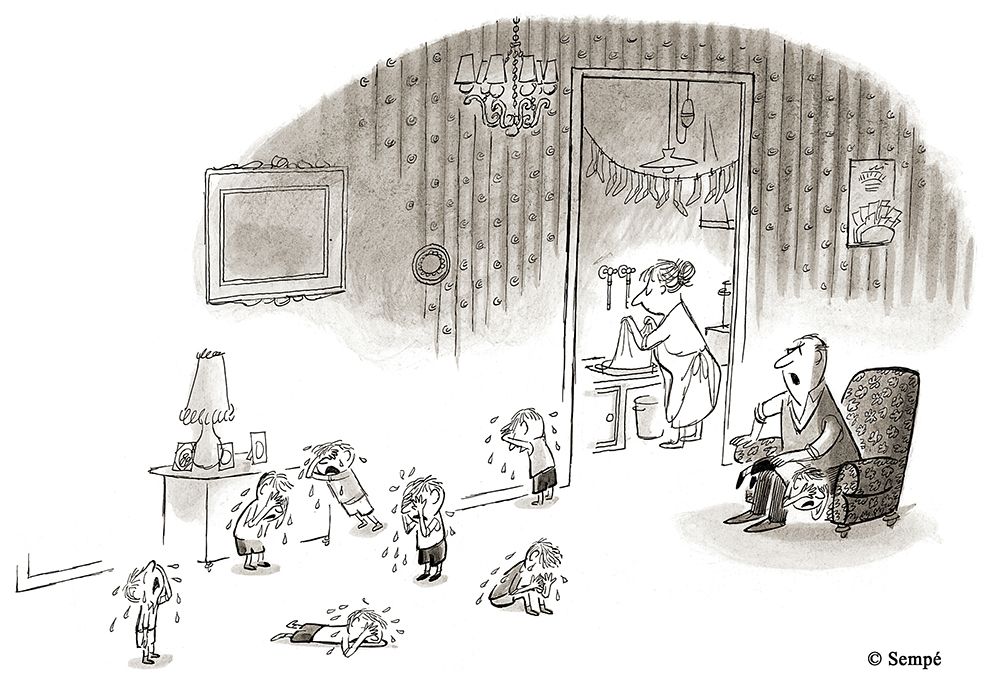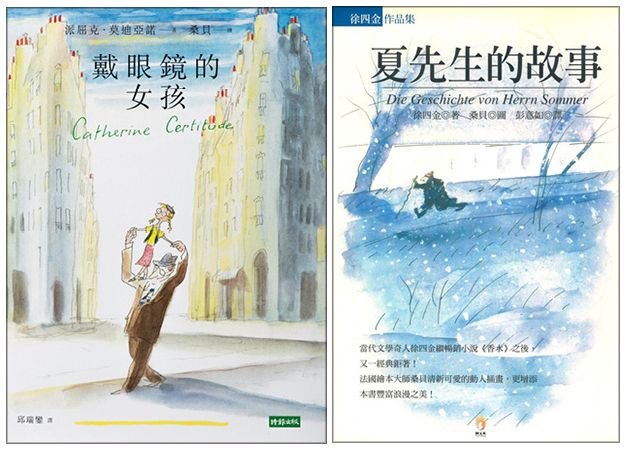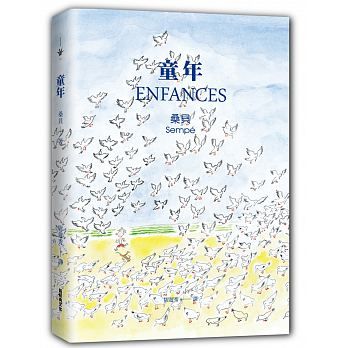In the stagnation on the eve of the storm, there will still be a ray of humor: Reading Sambe's "Childhood"

Author| Ye Weizhong (literary worker)
Editor's note: French illustrator Jean-Jacques Sempé has drawn illustrations for many well-known writers, including Nobel Prize winner Modiano's "Girl with Glasses" and Xu Sijin's "Mr. Xia's Story". Among them, the works most familiar to Taiwanese readers are such as "Little Naughty Nicholas", "Why Marcelin Blush" and other graphic books mainly for children. His paintings are often humorous with irony, expressing the innocence and mischief of human nature. In the Chinese biography "Childhood" published in 2017, in addition to describing the process of learning to paint, the reasons for the creation of the "Naughty Nikolai" series, as well as many unpublished paintings and the artist's first-hand interpretation, Sangbei also What is eye-catching is the childhood encounters he disclosed in the interviews, and the huge contrast with the tone of his works is surprising and embarrassing. Let's see how Sangbei's "iron fan" Ye Weizhong interprets the rift between the dream and reality in Sangbei's works.

Each of Sangbe's paintings is full of sound, even if there is no textual mention. Whether it's a plane flying far across the sky, or a bicycle sliding down a country lane, or a believer confronting God in an empty church, or a child's playful laughter, or even the traces left in the last moment, the footprints on the beach, the woods The shadows in the rink, the texture of the skates on the ice rink.
In addition, there are the joyous sounds of the four seasons, accompanied by and surrounded by the performance of the music. . . . Sambe not only likes music, but also likes to paint musicians. In the album Les Musiciens ( Les Musiciens ), each page is filled with portraits of confident and contented musicians. What they have in common: the slightly upward curvature of the corners of the mouth, matched with half-closed eyelids, or downcast eyes, or pupils condensed into a little bit, forming a moving smile.
Although we cannot hear, we can see the sound. Now through "Childhood", we hear Sanbe's own voice, the voice on the other side of lines and colors.
"Childhood" is a conversation between Sambe and journalist Marc Lecarpentier about his childhood, his past, his life experiences. The rhythm of the whole book is coherently fast, not only there is no cold scene, but occasionally there is a passion for excitement. For readers who are familiar with Sambei's works but do not know his life, they may also be shocked by his successive waves of childhood misfortunes. .

The childhood in Sanbei's memory and the world he described were actually two completely different voices. Sangbei has a picture album titled "Gorgeous, Tranquil, and Free" (Taiwan's translation of " Luxury, Tranquility and Pleasure ", Yushan Society), with the title of Baudelaire's famous poem, which coincides with the embarrassment of his childhood environment, The parental fighting and quarrels contrast sharply with the frustrations of everyday life.
But if we reread Childhood once (Sangbei's works can be read two or three times in succession), and replace it with his brushstrokes, gentle speed, and extending the words into pictures, we will find that in the The gap between misfortune and happiness, between escape and confrontation, is not that big.
First of all, in order to bridge the gap between the two worlds of dream and reality, the most common tool children use is: lies. Sanbe is no exception.
Despite the exaggeration, and as outrageous as it is, Sambey does not defend his lies. Lies have their own space and patterns, as Sanbe explained in " Hawuler's Secret " with a story that is more emotional than a fable:
Harwooler, the owner of a bicycle shop with a talent level, doesn't have a bike that he can't repair, but he can't ride a bike himself. Because no one believed the truth, he had to avoid breaking the illusion in embarrassment. A photographer came to the town, and they became best friends. Instigated by his friends, Hawule took advantage of wine to strengthen his courage, and the two completed a world-shattering masterpiece. The heroic photos of Harwooler's bicycle flying over the valley made them famous overnight. After recovering from his serious injuries, Hawule became unhappy, withdrawn and irritable, and alienated from the photographer. Because, he thought he was lying, he was embarrassed to lose control and fell into the valley, but he deceived the world. In the end, the misunderstanding was cleared up, the feat of life and death and the capture of the artistic shutter were just unexpected achievements that could not be controlled.
With all manner of wit and lies, Sanbe survived many difficulties and hurdles in his childhood, including language barriers. Readers will break into a cold sweat for him, but not into apprehension.
We don't blame him for lying, but also feel the innocence of Sanbei. Pure lies, just falsehoods. And cheating, often because of shyness. The shy nature of the French is often overlooked due to the rarity of the taciturn French.
Sambey is supposed to be a very shy French by nature, and shyness is also a major theme of his works. Shyness is the other side of a lie, and a hazy distance from the world.

In "Childhood", Sangbei's shy reaction is everywhere, the throbbing in the face of death, and the coy in the face of love... How do you date the girl you like without half a dime in your pocket? Let Sanbe teach you with shy falsities.
Lying and shyness are ways of communication that are too much and not enough. Their starting point is in interpersonal relationships, and they have to express something. But we can't escape like this forever. In the gap between life dilemma and interpersonal communication, the best expression, or the balance point, is humor.
Starting from the earliest "Little Naughty Nikolai", for half a century, dozens of picture albums, picture books, novel illustrations, the soul of Sanbei's creation is his unique humor.
Humor is easy to appreciate, but hard to retell. If you try to look at it the other way around: Sanbe almost never paints a frightened look on his face. Even in the tense parent-child relationship, the stagnant stalemate between parents and children, and the silence on the eve of the storm, there is still a ray of humor on the screen.
Compared with Gosini, the author of the "Nikola" series, Gosini's humor is to tell the disasters of the world through innocent eyes, while Sambe's humor is more realistic and helpless, just like Harwooler's. Encounter, incorporates more naturalness, and captures the accidental side of life.

Thanks to the translator for conveying the humorous tone of Sambe's words so vividly that we can hear it. I thought of a painting by Sangbe: Before the curtain of the Opera House, in the darkness of the lights out, a lady sitting in the box above the orchestra, the necklace is broken, dozens of pearls have fallen, (ding Lin Dong Long) percussion on two timpani.
At the bottom of the screen there are only two loud words in capital letters: "My necklace!" I think it not only translates Sanbei's point of view on life, but is more suitable as a footnote for this book: as if I heard Sanbei shouting "My Necklace!" Childhood!" And every page, every paragraph, is a piece of humor that falls on readers' hearts.
Of course, we will not use this book as a starting point to know Sambe, but it will be another starting point, strung with another necklace of painting and poetry. ●( The original text was first published on the OPENBOOK official website on 2017-03-24)

childhood
Enfances
Author: Jean-Jacques. Jean-Jacques Sempé
Translator: Yu Chixiu Publishing: New Classic Graphic Communication Company
About the Author:
Shang - Jacques. Sambe <br class="smart">Born in 1932 in Bordeaux. Since his creative career in the 1960s, he has published more than 40 collections. These include impressive characters such as Nicholas (with René Goscinny), Marcellin Caillou, Raoul Taburin. The most indispensable elements of his creation are: elegant humor with a hint of metaphor and clever irony, using irony that makes people laugh, expressing the shortcomings and flaws of human nature. Currently, he is a regular illustrator with well-known magazines " L'express ", " Télérama " and "New Yorker ". He has held solo exhibitions in New York, London, Munich, and Salzburg. His works have sold copyrights in Germany, the United Kingdom, the United States, Italy, China, South Korea, and Russia. He is the most popular well-known cartoonist and illustrator in the world. .
Like my work? Don't forget to support and clap, let me know that you are with me on the road of creation. Keep this enthusiasm together!



- Author
- More